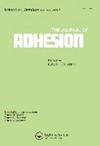如何用扩展流变仪从一开始就预测固化胶粘剂的残余应力
IF 2.3
4区 材料科学
Q2 ENGINEERING, CHEMICAL
引用次数: 0
摘要
摘要:预测粘接接头中的残余应力是从业者的一个主要话题,因为它们会导致失效。相关材料性能的实验测定,如收缩、模量发展和松弛行为,被认为是非常复杂的。粘弹性和数值模型通常被简化以适应特定的应用。然而,它们中的大多数没有考虑所有相关参数或固化过程的有限部分。本出版物解决了缺乏实验方法来确定反应性粘合剂的固化相关性能,并将其用作有限元建模的输入,以预测固化引起的应力的问题。作者专注于扩展旋转流变仪(ExRheo),以确定三种粘合剂的收缩、剪切模量和松弛与固化时间的相关性。通过DSC和动力学模型确定了粘弹性性能变化、收缩率和固化度之间的关系。实验结果被建模以在数值分析中实现,以便预测ExRheo中约束流变实验中的固化诱导应力。数值计算结果与实验结果吻合较好,验证了该方法的正确性。首次在没有任何假设的情况下,仅基于使用单个设备的直接实验数据,对固化过程中收缩引起的残余应力进行了从头计算建模。本文章由计算机程序翻译,如有差异,请以英文原文为准。
How to predict residual stresses of curing adhesives ab initio solely using extended rheometry
ABSTRACT Prediction of residual stresses in adhesively bonded joints is a major topic among practitioners, as they significantly contribute to failure. The experimental determination of relevant material properties, like shrinkage, modulus development, and relaxation behavior, is considered highly complex. Viscoelastic and numerical models are often simplified to suit specific applications. However, most of them do not consider all relevant parameters or limited portions of the curing process. This publication addresses the lack of experimental methods to determine cure-dependent properties of reactive adhesives to use them as input for FE modelling to predict cure-induced stresses. The authors focus on extended rotational rheometry (ExRheo), to determine shrinkage, shear modulus, and relaxation in dependency of curing time for three adhesives. The relationship between change of viscoelastic properties, shrinkage, and curing degree is determined through DSC and kinetic modelling. The experimental results are modelled to be implemented in a numerical analysis in order to predict cure-induced stresses in constrained rheological experiment in ExRheo. Numerical results show very good agreement with the experiments, which validate the methodology. For the first time, shrinkage induced residual stresses are modelled ab initio over the curing process, without any assumptions, solely based upon direct experimental data using a single device.
求助全文
通过发布文献求助,成功后即可免费获取论文全文。
去求助
来源期刊

Journal of Adhesion
工程技术-材料科学:综合
CiteScore
5.30
自引率
9.10%
发文量
55
审稿时长
1 months
期刊介绍:
The Journal of Adhesion is dedicated to perpetuating understanding of the phenomenon of adhesion and its practical applications. The art of adhesion is maturing into a science that requires a broad, coordinated interdisciplinary effort to help illuminate its complex nature and numerous manifestations.
 求助内容:
求助内容: 应助结果提醒方式:
应助结果提醒方式:


